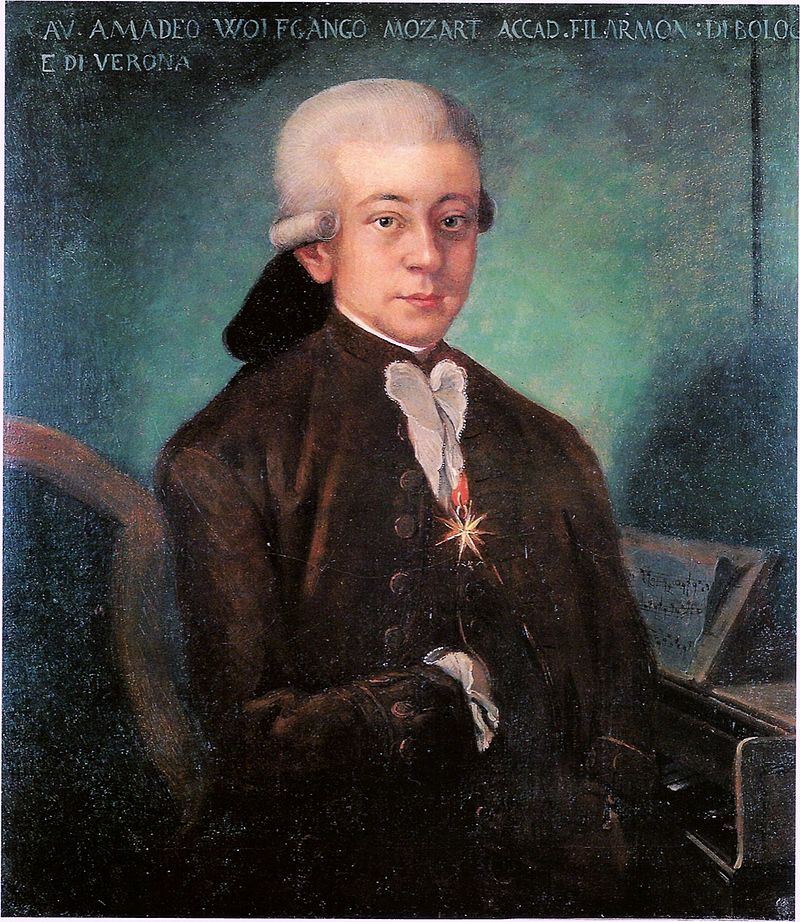
I’ve been working on this piece for a few months, and have finally completed the theme and all 12 variations. The piece is a masterpiece, in my opinion. That it was written when Mozart was only 19 years old is astonishing. That he was never paid for it is one of the many injustices done to poor Wolfgang. Wiki for more info.
The piece is in D major, with the exception of the 7th variation, which is in D minor. The basic harmony includes the chords D major, B minor, E minor & major, and A major and some diminished chords.
The tuning is taken from the tonality diamond to the 31-limit. I chose three 16-note scales from to utonality, and one from an otonality.
| O/U | Root | Key | 3rd | |
|---|---|---|---|---|
| O | 16:9 | Bb | D | 5:4 |
| U | 5:3 | A | D | 9:7 |
| U | 5:3 | A | B | 7:6 |
| U | 5:4 | E | A | 9:7 |
To derive a scale I used three 16-note utonality or otonality scales from the 31-limit diamond. The first column in the table determines if the scale is either otonal or utonal. The root is the base note for the 16 note scale.
The first row shows 16:9 Bb otonality as the origin of the 16 note scale. I derive a mode from that scale based on choosing the D (10:9) as the root of the scale in the piece.
The next row shows the 5:3 A utonality as the origin of a 16 note scale, with the root on D 10:9. The next one is from the same 5:3 A utonality, but with the root on 15:8 B. The last row takes a mode from the 5:4 E utonality with A 5:4 as the root.
This generated several scales:
| D maj 1 | ||||||||
| Note | D | E | F# | G | A | B | C# | D |
| Cents | 0 | 242 | 386 | 520 | 702 | 919 | 1111 | 1200 |
| Ratio | 1:1 | 23:20 | 5:4 | 27:20 | 3:2 | 17:10 | 19:10 | 2:1 |
| D maj 6 | ||||||||
| Note | D | E | F# | G | A | B | C# | D |
| Cents | 0 | 204 | 435 | 498 | 702 | 933 | 1106 | 1200 |
| Ratio | 1:1 | 9:8 | 9:7 | 4:3 | 3:2 | 12:7 | 36:19 | 2:1 |
| B min 1 | ||||||||
| Note | B | C# | D | E | F# | G# | A# | B |
| Cents | 0 | 1732 | 267 | 471 | 702 | 898 | 1119 | 1200 |
| Ratio | 1:1 | 21:19 | 7:6 | 21:16 | 3:2 | 42:25 | 21:11 | 2:1 |
| A maj 2 | ||||||||
| Note | A | B | C# | D | E | F# | G# | A |
| Cents | 0 | 204 | 435 | 498 | 702 | 933 | 1106 | 1200 |
| Ratio | 1:1 | 9:8 | 9:7 | 4:3 | 3:2 | 12:7 | 36:19 | 2:1 |
The D major 1 scale, in addition to a decent D major, has a fair A major with neutral/sub minor third, a good B major and minor scale, and a good G major scale. When these chords are needed, I chose the D major 1 scale.
The D6 major has a great A minor, with a 6:5 minor, and 409 cent major third. It has a nice G major, with a 9:7 very sharp but usable major third. It also has a decent B minor,
The B minor 1 scale has a good F for the D minor variation.
The A major 2 scale has the best E major and minor, which are frequently used in the piece. The minor is 6:5 and the major is 24:19, 4 cents above a 12-TET major third, which is what was common at the time. This scale also has a decent D major and A major scales, a little high on the major third.
As you can see, there are lots of strange notes in this set of scales. I like to call them puns
on the target ratio. I have one 5:4 third, and two 9:7’s and a 7:6, not ordinarily trusted as major and minor thirds. The fourths should be 4:3, yet I have a 27:20, 21:16, along with two 4:3. All four have a good 3:2 fifth, but all were selected to have perfect fifths.
To chose which of the four scales to use for each measure, I played them to see which sounded best for each measure. This lead to situations where an F# might vary by 50 cents from one measure to another, so I would often go back and choose a different scale instead of the one chosen originally.
I don’t mean to imply that this is a good
or historically relevant tuning for this piece. I’m sure the maestro was rolling over in his grave at the heresy of this ahistorical tuning of the piece. But this is 2018 and Trump is President.
I did it as an experiment and found that the tuning appears less grating the more you listen to it, and it can grow on you if you don’t run screaming from the room too quickly.
The performance was realized in Csound using Prent’s Microtonal Slide Bosendorfer (commercial Emporer
samples). The only slides are in variation #11, where they are frequently used as grace notes and sometimes as trills.
or download here:
Mozart K284 Theme and Variations
